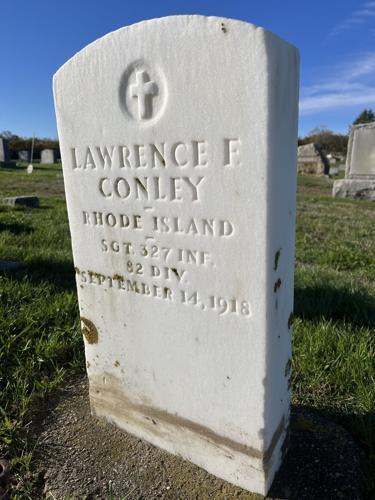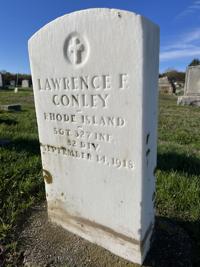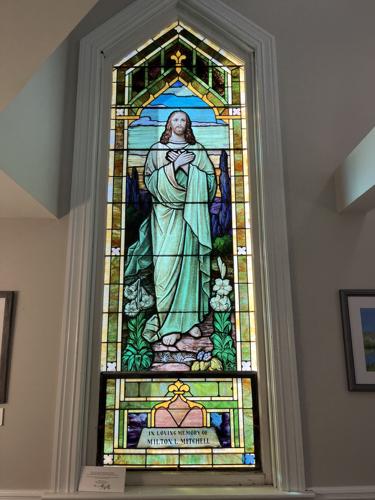On a day in late July, 1921, the Block Island community gathered on the dock for the arrival of the ferry named New Shoreham. Onboard were not only tourists, but also the mortal remains of three Block Islanders who, in the final months of World War I, died in the trenches of the Western Front. Many of the 60 Block Island veterans who survived the war were among those gathered on the dock for the start of three funerals.
“War to end all wars”
World War 1 (1914-1918) combined the deadly efficiency of 20th century technology with military leaders using the century-old tactics of Napoleon. Millions of lives were extinguished by artillery, chemical weapons, the first use of tanks and submarines, German airships called Zeppelins bombing population centers, and suicidal charges against enemy trenches fortified with machine guns. One English veteran named J.R.R. Tolkien, who fought on the Western Front in France, could only process the horrific events he witnessed firsthand by writing “The Hobbit” and “The Lord of the Rings.”
Besides consuming nearly twenty million human lives, this war ended centuries-long monarchies overseeing empires. A different world emerged in 1918. Mapmakers saw a bonanza in business after the war as the Russian, Ottoman, and Austro-Hungarian Empires ceased to exist and were replaced by the new political constructions called Turkey, the Soviet Union, Iraq, Poland, Palestine, and Czechoslovakia (among others). Writers such as Hemingway and F.S. Fitzgerald wrote and drank in postwar Paris, seeking to make sense of this new world. Many communities, including Block Island, sought to anchor the memory of those lost in the war with memorials composed of granite.
Along Block Island’s Center Road is a World War I memorial composed of glass.
Primitive Methodist Church
In 1907, the Primitive Methodist Church was constructed. It still stands today and along the southern wall is a window depicting a barefooted Christ in a rich array of greens, blues, purples, and hints of orange. A pane of glass on the bottom reads: “In Loving Memory of Milton L. Mitchell.”
The wooden pews of the Primitive Methodist Church were full on that summer day in 1921 for the funeral of Milton Mitchell. In this church he was both married and served as a Sunday School teacher. “He loved his church and during the long and perilous days at the front often wrote cheerful letters to Rev. A. Hesford, then the pastor of his church,” a short biography of Milton read, “and anxiously counted the days when he hoped to return to his wife and child and again be privileged to worship his God in common with his dear friends on Block Island.”
All-American Division
Milton L. Mitchell was born on Block Island on January 9, 1895. In 1914, he started working as a message carrier for the Weather Bureau on Block Island’s Beach Avenue. He served in this role until he entered the United States Army on September 18, 1917. His unit, the 82nd Division, was called the All-American Division as it was composed of soldiers from all 48 states. Arriving in France in September 1918, the 82nd experienced combat in short order, facing waves of battle-tested German forces recently freed up from the eastern front with the Russian withdrawal from the war.
Mitchell participated in the St. Mihiel and Meuse-Argonne offensives. “He had several times been offered an appointment or transfer to a branch of the YMCA service situated some miles in the rear of the actual line of battle,” his obituary read, “but each time he refused, saying that he preferred to stick with the boys through thick and thin.” During the battle of Argonne Forest, when his captain was wounded, Mitchell took over command. Soon after, in fierce fighting, Mitchell himself was severely wounded. He passed away the following day. He was buried in the cemetery near the small French village of Villers-Bancourt.
The war to end all wars ended less than a month later.
New Shoreham
On that summer day in late July in 1921, Block Island’s World War I veterans stood at attention. Nearby, the ferry vessel New Shoreham docked with the mortal remains of Lawrence F. Conley, Arnold R. Milliken and Milton L. Mitchell aboard. “When the steamer New Shoreham pulled into her dock on Friday afternoon,” a reporter on the scene wrote, “bearing the three bodies of Block Island’s war heroes, a deep silence overawed the vast throng of relatives and friends of those who had paid the supreme sacrifice on the battle fields of France.” Veterans with surnames that included Dodge, Milliken, Mitchell, Rose, Ball, Littlefield, Negus, Northup, Payne, and Steadman, attended the three funerals and visited the Island Cemetery for three burials.
Adrian’s gift
I first heard about Milton Mitchell from the nephew he never met. When Milton was buried in the Island Cemetery in 1921, he left behind three brothers, Adolphus, Ernest and Adrian E. Mitchell. His younger brother Adrian, some two decades later, welcomed a son into the world also named Adrian.
Most of you reading this knew Adrian Mitchell a great deal longer than I did. In the 20 years I knew Adrian, no matter the time of year, he would talk with me in detail about two things. First, needed changes in the Red Sox pitching rotation. Second, Block Island history. Adrian not only told me about his uncle Milton, but also having Fred Benson as a teacher, attending the dedication of the Block Island State Airport (1950) and the State Beach Pavilion (1954), the 1961 Tricentennial events, and of Capt. Rob Lewis asking him to be on the board of the Block Island Conservancy.
In my last conversation with Adrian this past summer, he talked with me in detail about joining the Block Island Fire Department at the age of 16. This included the first major Block Island fire he participated in, when in April of 1963, the Searles Mansion, which was within eyesight of his home on Mitchell Farm, burned down. As the Block Island Volunteer Fire Department commemorates a century of service this year, my last chat with Adrian will assist greatly in a series of upcoming articles on the department’s history since its founding in 1925.
This series will commence next week with the Mansion fire. Thank you for the stories, Adrian.






